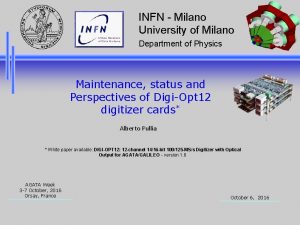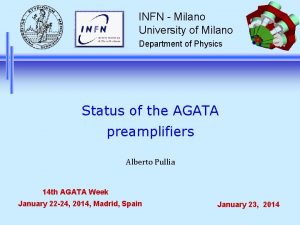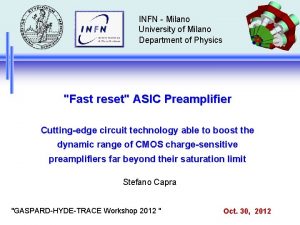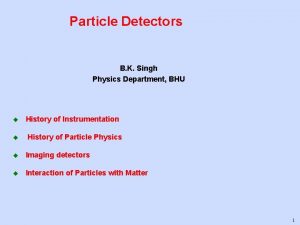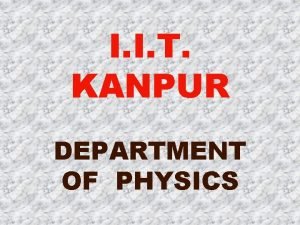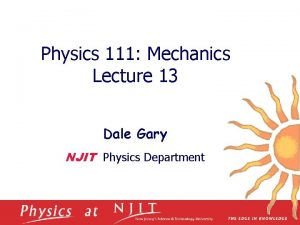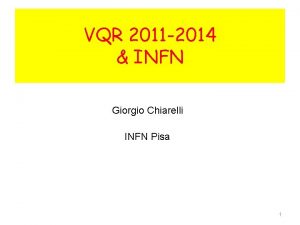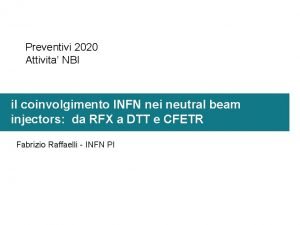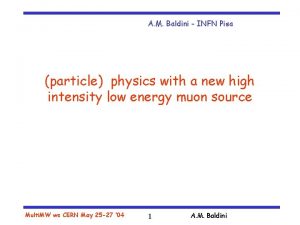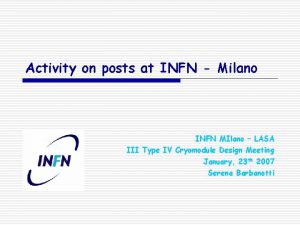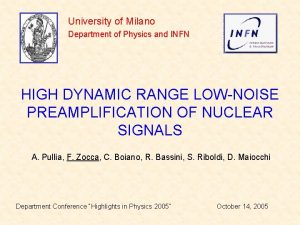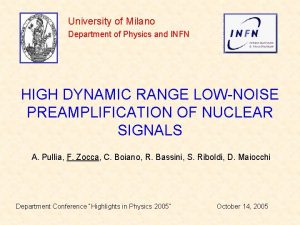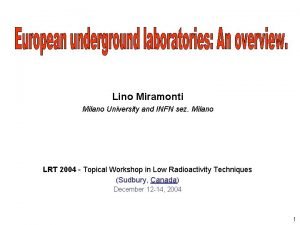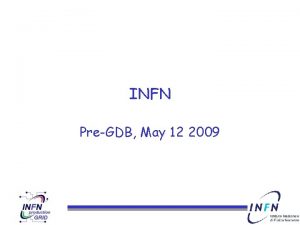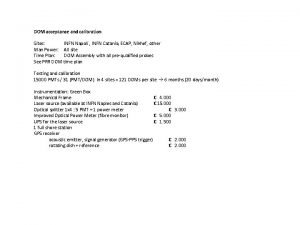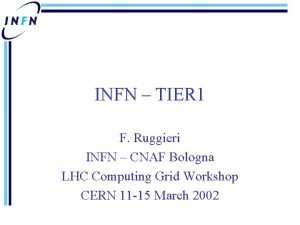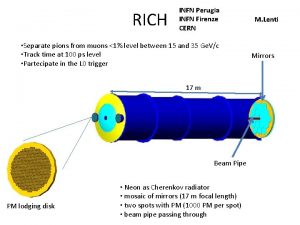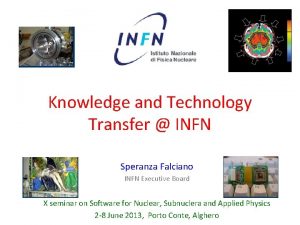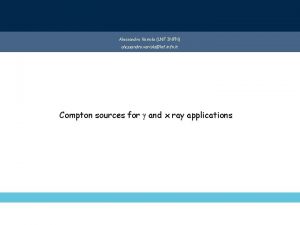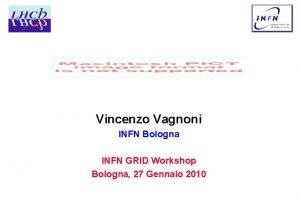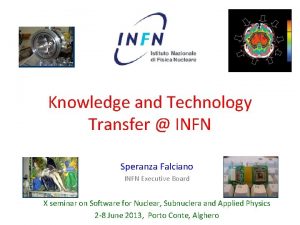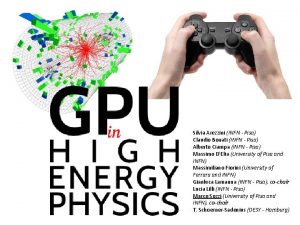University of Milano INFN Milano Department of Physics



































- Slides: 35

University of Milano INFN - Milano Department of Physics JRA 02 - AGATA Going beyond the ADC limit in AGATA with a Time-over-Threshold technique and first results with an ASIC preamplifier for Ge detectors Francesca Zocca FREEDAC meeting Ljubljana 2008, May 28 th

JRA 02 - AGATA Time-over-Threshold (TOT) technique for AGATA preamplifiers

The issue of ADC saturation & system dead time Exotic nuclei are to be disentangled in a hostile environment of high background radioactivity: (Bremsstrahlung, neutrons, charged particles…) g ( 1 -10 Me V) Background of energetic particles JRA 02 - AGATA HPGe segmented detector p K ( 10 -100 Core Me. V) The preamplifier output signals are directly digitized: shaping, filtering and pulse shape analysis are made on the digitized signals Segments charge preamplifier From detector Second stage charge loop Antialias ADC Individual highly energetic events or bursts of piled-up events could easily cause ADC SATURATION and introduce a significant SYSTEM DEAD TIME

Mixed reset technique: continuous + pulsed JRA 02 - AGATA Saturated output without pulsed-reset Ideal non-saturated output without pulsed-reset ADC overflow voltage level Preamplifier output with continuous-reset (50 s decay time constant) An ADC overflow condition would saturate the system for a long while Output with pulsed-reset A fast-reset mechanism allows a fast recovery of the output quiescent value, so minimizing the system dead time

Fast-reset device PACAGA 5 A (GANIL) AGATA_ core-pulser (KOELN) PB-B 1 - MI (MILANO)

Fast-reset device PACAGA 5 A (GANIL) AGATA_ core-pulser (KOELN) PB-B 1 - MI (MILANO)

Fast-reset device PACAGA 5 A (GANIL) AGATA_ core-pulser (KOELN) PB-B 1 - MI (MILANO)

Time-Over-Threshold (TOT) technique

Time-Over-Threshold (TOT) technique second-order time-energy relation E = energy of the large signal T = reset time offset term

Time-Over-Threshold (TOT) technique second-order time-energy relation offset term contribution of the tail due to previous events E = energy of the large signal T = reset time V 1 , V 2 = pre-pulse and post-pulse baselines b 1 , b 2 , k 1 , E 0 = fitting parameters

Time-Over-Threshold (TOT) technique second-order time-energy relation offset term contribution of the tail due to previous events E = energy of the large signal T = reset time V 1 , V 2 = pre-pulse and post-pulse baselines b 1 , b 2 , k 1 , E 0 = fitting parameters Within ADC range standard “pulse-height mode” spectroscopy Beyond ADC range new “reset mode” spectroscopy

Experimental setup with the AGATA capsule JRA 02 - AGATA Encapsulated AGATA HPGe crystal at LNL built-in pulser Core preamplifier

Calibration procedure Parameters calculated by a fitting procedure Parabolic fitting curve Calibration pulser signals are completely disentangled from the background

TOT technique applied to overthreshold pulser signals (1) Pulser signal @ 5. 97 Me. V 60 Co background rate = 1. 3 k. Hz 60 Co background rate = 14. 5 k. Hz

TOT technique applied to overthreshold pulser signals (2) 60 Co background rate = 1. 3 k. Hz Resolution @ 5. 97 Me. V = 10. 5 ke. V (0. 18 %) 60 Co background rate = 14. 5 k. Hz Resolution @ 5. 97 Me. V= 15. 2 ke. V (0. 25 %)

TOT technique applied to overthreshold pulser signals (3) Background event rate = 800 Hz Pulser line energy Resolution (fwhm) E 1 = 3. 3501 Me. V 11. 68 ke. V 0. 35 % E 2 = 5. 9720 Me. V 11. 42 ke. V 0. 19 % E 3 = 10. 656 Me. V 11. 28 ke. V 0. 11 % E 4 = 18. 797 Me. V 12. 55 ke. V 0. 067 % E 5 = 33. 369 Me. V 14. 33 ke. V 0. 043 % E 6 = 49. 434 Me. V 19. 16 ke. V 0. 039 % Better than 0. 4% over the full range Pulser energy = 5. 97 Me. V Pulser energy = 10. 65 Me. V Pulser energy = 18. 8 Me. V Event rate Resolution (fwhm) 1. 3 k. Hz 10. 50 ke. V 0. 18 % 1. 2 k. Hz 12. 07 ke. V 0. 11 % 1. 3 k. Hz 12. 94 ke. V 0. 069 % 2. 3 k. Hz 11. 79 ke. V 0. 20 % 2. 4 k. Hz 12. 97 ke. V 0. 12 % 2. 3 k. Hz 15. 56 ke. V 0. 083 % 4. 2 k. Hz 12. 57 ke. V 0. 21 % 4. 2 k. Hz 14. 02 ke. V 0. 13 % 4. 2 k. Hz 18. 64 ke. V 0. 10 % 8. 2 k. Hz 13. 23 ke. V 0. 22 % 8. 2 k. Hz 17. 87 ke. V 0. 17 % 8. 2 k. Hz ~ 30 ke. V 0. 16 % 14. 5 k. Hz 15. 18 ke. V 0. 25 % 14. 5 k. Hz 22. 56 ke. V 0. 21 % 14. 2 k. Hz ~ 40 ke. V 0. 21 %

TOT technique applied to overthreshold pulser signals (3) Background event rate = 800 Hz Pulser line energy Resolution (fwhm) E 1 = 3. 3501 Me. V 11. 68 ke. V 0. 35 % E 2 = 5. 9720 Me. V 11. 42 ke. V 0. 19 % E 3 = 10. 656 Me. V 11. 28 ke. V 0. 11 % E 4 = 18. 797 Me. V 12. 55 ke. V 0. 067 % E 5 = 33. 369 Me. V 14. 33 ke. V 0. 043 % E 6 = 49. 434 Me. V 19. 16 ke. V 0. 039 % Better than 0. 4% over the full range Pulser energy = 5. 97 Me. V Pulser energy = 10. 65 Me. V Pulser energy = 18. 8 Me. V Event rate Resolution (fwhm) 1. 3 k. Hz 10. 50 ke. V 0. 18 % 1. 2 k. Hz 12. 07 ke. V 0. 11 % 1. 3 k. Hz 12. 94 ke. V 0. 069 % 2. 3 k. Hz 11. 79 ke. V 0. 20 % 2. 4 k. Hz 12. 97 ke. V 0. 12 % 2. 3 k. Hz 15. 56 ke. V 0. 083 % 4. 2 k. Hz 12. 57 ke. V 0. 21 % 4. 2 k. Hz 14. 02 ke. V 0. 13 % 4. 2 k. Hz 18. 64 ke. V 0. 10 % 8. 2 k. Hz 13. 23 ke. V 0. 22 % 8. 2 k. Hz 17. 87 ke. V 0. 17 % 8. 2 k. Hz ~ 30 ke. V 0. 16 % 14. 5 k. Hz 15. 18 ke. V 0. 25 % 14. 5 k. Hz 22. 56 ke. V 0. 21 % 14. 2 k. Hz ~ 40 ke. V 0. 21 % Obtained resolutions better than 0. 25% for all the tested count rates

Experimental setup: 241 Am+Be AGATA capsule at LNL 241 Am+Be source with Ni target Fast neutrons thermalized in paraffin and captured by natural metallic nickel g-photons produced in the 4 to 9 Me. V range source

241 Am+Be spectrum in pulse-height mode Energy Resolution (fwhm) in “pulse-height” mode 1. 1732 Me. V (60 Co) 2. 99 ke. V 0. 25 % 1. 3325 Me. V (60 Co) 3. 24 ke. V 0. 24 % 2. 2233 Me. V (H) 4. 51 ke. V 0. 20 % 4. 440 Me. V (12 C) 104 ke. V 2. 34 % 7. 6312 Me. V (Fe) 11 ke. V 0. 14 % 7. 6456 Me. V (Fe) 11 ke. V 0. 14 % 8. 9984 Me. V (Ni) 15 ke. V 0. 17 %

241 Am+Be spectrum in pulse-height mode Energy Resolution (fwhm) in “pulse-height” mode 1. 1732 Me. V (60 Co) 2. 99 ke. V 0. 25 % 1. 3325 Me. V (60 Co) 3. 24 ke. V 0. 24 % 2. 2233 Me. V (H) 4. 51 ke. V 0. 20 % 4. 440 Me. V (12 C) 104 ke. V 2. 34 % 7. 6312 Me. V (Fe) 11 ke. V 0. 14 % 7. 6456 Me. V (Fe) 11 ke. V 0. 14 % 8. 9984 Me. V (Ni) 15 ke. V 0. 17 %

241 Am+Be spectrum in pulse-height mode Energy Resolution (fwhm) in “pulse-height” mode 1. 1732 Me. V (60 Co) 2. 99 ke. V 0. 25 % 1. 3325 Me. V (60 Co) 3. 24 ke. V 0. 24 % 2. 2233 Me. V (H) 4. 51 ke. V 0. 20 % 4. 440 Me. V (12 C) 104 ke. V 2. 34 % 7. 6312 Me. V (Fe) 11 ke. V 0. 14 % 7. 6456 Me. V (Fe) 11 ke. V 0. 14 % 8. 9984 Me. V (Ni) 15 ke. V 0. 17 %

241 Am+Be spectrum in reset mode

241 Am+Be spectrum “reset” mode (by TOT technique) Energy Resolution (fwhm) in pulse-height mode Resolution (fwhm) in reset mode 4. 440 Me. V (12 C) 104 ke. V 2. 34 % ~5. 6 Me. V 10. 5 ke. V 0. 14 % 18. 8 ke. V 0. 34 % ~6. 1 Me. V 15. 1 ke. V 0. 17 % 17. 1 ke. V 0. 28 % 7. 6312 Me. V (Fe) 11 ke. V 0. 14 % 7. 6456 Me. V (Fe) 11 ke. V 0. 14 % 18. 8 ke. V (29. 4 ke. V for the doublepeak) 0. 25 % (0. 38 % for the doublepeak) 8. 9984 Me. V (Ni) 15 ke. V 0. 17 % 18. 9 ke. V 0. 21 % “pulse-height” mode (by ADC)

Comparison on the 8. 99 Me. V Ni line “pulse-height” mode FWHM = 15 ke. V ( 0. 17 % ) “reset” mode FWHM = 19 ke. V ( 0. 21 % ) At high energies the performance in reset mode approaches the performance in pulse-height mode

The ideal acquisition chain: “dual -range” core preamplifier JRA 02 - AGATA Reset threshold ~ 10 Me. V ~ 5 Me. V 1 st channel 2 nd channel ~ 20 Me. V Result : Pulse-height mode (ADC ~ 5 Me. V) Pulse-height mode (ADC ~ 20 Me. V) Reset mode (from ~ 20 Me. V on)

First results with an ASIC preamplifier for Ge detectors

The realized JFET-CMOS preamplifier DC-coupled, optimized for negative signals (hole signals), fully functional at cryogenic temperature 5 V 0. 8 m CMOS technology provided by Austria Micro Systems M 3 holes for mounting VD test 23 mm Inspired to that proposed in : J. Gal et al. “Realization of charge sensitive preamplifiers using current feedback operational amplifier”, Nucl. Instrum. And Meth. , Vol. A 366, pp. 145 -147, 1995 det out Integrated circuit and discrete devices as mounted on a Printed Circuit Board of 0. 8 mm teflon (PTFE) laminate VEE VCC 47 mm

The proposed CMOS output stage: a selfadjusting constant-current source follower M 2 (n-MOS) is the “sourcefollower” transistor, whose current is kept constant by the negative feedback loop M 1 (n-MOS) acts as a “driver” transistor, and provides the load current whenever a negative output signal is present Inserted into the loop of a negative feedback amplifier to guarantee the best overall circuit linearity (mandatory for gamma-ray spectroscopy)

First test-bench characterization Negative output voltage swing of -2. 5 V against a negative power supply of -2. 7 V CF = 0. 2 p. F dynamic energy range = ~ 8. 6 Me. V (CF= 1 p. F dynamic energy range = ~ 45 Me. V) Rise time of ~ 13 ns (1 m 50 W terminated cable) Rise time of ~ 15 ns (10 m 50 W terminated cable) Cdetector = 15 p. F Minimum ENC ~ 110 e- rms (0. 76 ke. V fwhm in HPGe) both at 300 K and 77 K

The BF 862 JFET at T=300 K and T=77 K T= 300 K From 300 K to 77 K the drain current and so the transconductance value decrease of a factor of 3 T= 77 K

Measurement results with HPGe detector Rise time ~ 16 ns Cdet ~ 60 p. F Shaping time Measurement made in Milano, April 2008, with detector setup “SUB” of GERDA experiment 0. 5 s 1 s 2 s 3 s 6 s 10 s Pulser line resolution ( ke. V fwhm) 3. 90 3. 16 2. 15 1. 99 1. 61 1. 60 60 Co line resolution (ke. V fwhm) 8. 37 4. 14 2. 85 2. 56 2. 25 2. 17

Summarized preamplifier performance T = 77 °K Energy sensitivity (CF = 0. 2 p. F) ~ 290 m. V/Me. V at preamp output ~ 217 m. V/Me. V after 150 W termination Negative output voltage swing ~ 2. 5 V Input dynamic range ~ 8. 6 Me. V Rise time ~ 16 ns with ~ 5 m coaxial cable Fall time ~ 250 s ( RF = 1. 2 GW ) Resolution 2. 2 ke. V @ 1. 332 Me. V ( 60 Co ) 1. 6 ke. V on pulser line Power required 23. 4 m. W (VFET = +4 V ID = 2 m. A VCC= +3. 6 V VEE = -2. 8 V)

Summarized preamplifier performance T = 77 °K Energy sensitivity (CF = 0. 2 p. F) ~ 290 m. V/Me. V at preamp output ~ 217 m. V/Me. V after 150 W termination Negative output voltage swing ~ 2. 5 V Input dynamic range ~ 8. 6 Me. V Rise time ~ 16 ns with ~ 5 m coaxial cable Fall time ~ 250 s ( RF = 1. 2 GW ) Resolution 2. 2 ke. V @ 1. 332 Me. V ( 60 Co ) 1. 6 ke. V on pulser line Power required 23. 4 m. W (VFET = +4 V ID = 2 m. A VCC= +3. 6 V VEE = -2. 8 V) low value of the feedback capacitance, for maximization of the signal-to-noise ratio (even if at the expense of the dynamic range) very low power consumption: JFET bias point: VD= 2. 32 V ID= 2. 1 m. A PJFET = 8. 3 m. W PASIC = 15. 1 m. W

Conclusions JRA 02 - AGATA l A TOT technique has been adopted for AGATA preamplifiers and demonstrated with an AGATA capsule and a 241 Am+Be source. The obtained resolution in “reset mode” is of < 0. 4 % in all the tested range on pulser signals from 3 Me. V to 50 Me. V. A remarkable resolution of 0. 21 % was obtained on the Ni spectrum line at the energy of 8. 998 Me. V. The energy measurement range can be extended of more than one order of magnitude l A JFET-CMOS preamplifier, able to operate at cryogenic temperatures, has been realized and tested with a HPGe detector. The output stage provides at the same time a low output impedance and a large voltage swing. Future development: integration of the fast reset device in CMOS technology

 Infn milano
Infn milano Infn milano
Infn milano Infn milano
Infn milano Department of physics university of tokyo
Department of physics university of tokyo Michigan state physics
Michigan state physics University physics with modern physics fifteenth edition
University physics with modern physics fifteenth edition Quasicrystals ppt
Quasicrystals ppt Physics 121 njit
Physics 121 njit Warwick physics department
Warwick physics department Bhu physics department
Bhu physics department Iit kanpur physics faculty
Iit kanpur physics faculty Kepler 4 njit
Kepler 4 njit Modern physics vs classical physics
Modern physics vs classical physics Physics ia ideas mechanics
Physics ia ideas mechanics Department of law university of jammu
Department of law university of jammu Department of geology university of dhaka
Department of geology university of dhaka University of padova psychology
University of padova psychology University of bridgeport it department
University of bridgeport it department University of iowa math department
University of iowa math department Texas state psychology
Texas state psychology Department of information engineering university of padova
Department of information engineering university of padova Department of information engineering university of padova
Department of information engineering university of padova Manipal university chemistry department
Manipal university chemistry department Syracuse university pool
Syracuse university pool Jackson state university finance department
Jackson state university finance department Webnis
Webnis Columbia university cs department
Columbia university cs department University of sargodha engineering department
University of sargodha engineering department Claudia arrighi
Claudia arrighi Giorgio chiarelli infn
Giorgio chiarelli infn Preventivi infn
Preventivi infn Www.lnf.infn.it
Www.lnf.infn.it Infn lab nazionale di legnaro, legnaro
Infn lab nazionale di legnaro, legnaro Infn gran sasso
Infn gran sasso Infn lnl
Infn lnl Infn pisa
Infn pisa
